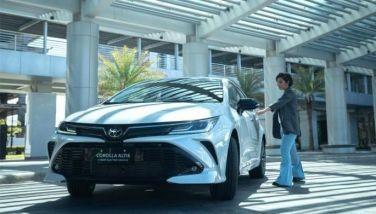A revenue regulation that can bring more harm than good
February 5, 2003 | 12:00am
Many in the local business circles especially those in the local automotive industry were shocked to know of a new regulation that would effectively mean a 35 percent to 50 percent excise tax on all AUVs or Asian Utility Vehicles. The new revenue regulation, which was signed by Finance Secretary Jose Isidro Camacho and BIR Commissioner Guillermo Parayno, takes effect in a very short notice of 15 days after its publication.
BIR RR 4-003 dated 29 January 2003 tightens the application of excise tax exemption by imposing strict seat measurements for determining seating capacity. Also under the new regulation, 4-wheel drive vehicles would no longer be exempted from the excise tax regardless of the number of seats.
This measure literally wipes out completely the excise tax exemption of all AUVs in the market today taking all its manufacturers by surprise. Being the beginning of the year, many consider the timing of the move so ridiculous, considering that yearlong and long-term business plans have been drawn as early as before the previous year ended. With this unprecedented move made by the Department of Finance, the entire landscape of the local automotive industry will be altered to the disadvantage of most of those in the industry and more so the buying public as it will definitely jack up the prices of these AUVs.
Some business observers say that it now appears that the government penalizes any sector that does well with additional tax burdens considering that the commercial vehicles category, to where the AUVs belong, last year grew by 21 percent, with the sale of AUVs alone registering a 39 percent increase. This move is tantamount to killing the goose that’s showing a huge potential to lay golden eggs. Presently the sale of AUVs is actually helping the industry keep itself afloat.
What are the consequences of this sudden and unprojected move of the government, which many consider as glowingly ill advised?
For people who may be considering buying an AUV–a great deal of additional investments would have to be shelled out due to the inevitable increase in its price. A quick computation to determine viability lead us to the following figures; Toyota’s Revo would have to start selling at P1,131,000 from P838,000; Mitsubishi’s Adventure to P844,000 from P795,000; the Honda’s CR-V at P1,294,000 from P959,000 and Isuzu’s Crosswind to P1,423,000 from P949,000.
That means those who may be contemplating on starting a business utilizing these AUVs may have to either postpone or entirely abort the idea–a scenario that would not be of much help to the government’s efforts to revive the economy.
For the automotive industry, the increase in prices would definitely lead to a much lower demand for the AUVs–a sector that has been keeping the industry afloat and alive as passenger car sales have considerably gone down by 8 percent. It would also affect the sales of SUVs, as their prices would definitely go sky high with the new revenue regulation. This radical decrease in demand can lead to production slowdown and worst, plant shut down.
Aside from being a "let down" for many in the industry, it would also sow confusion, not only within the automotive sector but also among present and would-be investors regarding policies that govern the conduct of business in the country–whether it is by legislation or by regulation. It is the contention of many business observers that the new regulation runs contrary to some legally established rules governing the conduct of the country’s automotive industry.
For the Pinoy workers the consequence can be more devastating. With the inevitable depressed demand for AUVs the natural reaction for the manufacturers is to lower present production and if the situation gets worse, even probably shut down plants. This means loss of jobs for the thousands presently employed in these plants.
By all indications the affected manufacturers would probably not take this sitting down nor would the workers who would stand to loose their jobs as a consequence of the new revenue regulation. It is very possible that legal means would be opted not to mention the possibility of more visible and dramatic protestations by those who would be most hit–the workers.
As we ask around, it is the contention of many business observers that from a macro point of view, this new revenue regulation may bring more harm than good to the government.
I was late for the presentation of the new Mitsubishi Motors Philippines offering in the passenger car category that’s exclusively for the media held last Wednesday at the Ballroom of the Dusit Hotel in Makati. Although rushing through traffic from the taping of our TV show Motoring Today that’s regularly done at Valle Verde Country Club in Pasig, which unexpectedly ended up late that day, I did not get to hear the well-crafted speeches that normally come with a car-launch, only the old circle of media men and our "family" of motoring journalists and of course the all-new Mitsubishi Lancer.
But being in the comfortable company of our "motoring family" while enjoying the sounds of the talented band Mitsubishi tapped for the occasion and seeing what some of our friends from Mitsubishi describe as the market offering that’s destined to shuffle present rankings in passenger car sales were more than what I bargained for as I snaked through EDSA’s unpredictable rush hour traffic.
After having taken a long look at the all-new Lancer, I think my friends Mel Dizon (future president of Mitsubishi Motors Philippines?) and Froy Dytianquin may have more than just a dream in their hands. Take these features; a diamond-cut nose design, honey-combed design chrome grille, color-keyed front bumper, chrome grip-type door handles, clear-lensed reflector type halogen headlamps, chrome body and side bumper mouldings, chrome scuff plates, 15-inch aluminum wheels, large rear combination lamps in the rear, high-mount stop light, MPH rear bumper and for the MX variant–a reverse sensor.
There are still a lot to mention about the all-new Lancer, like it being taller, wider and longer than its predecessor, which make its occupants enjoy more legroom plus a front seat design that allows feet to be extended beneath the seat and a bigger trunk that can accommodate 430 liters of cargo space. The top-of-the-line MX models have soft leather seating with woodgrain trim in the dashboard and equipped with a 6-disc CD/VCD changer and a 6.5-inch LCD display.
But, what I think takes the cake is the CVT (Continuously Variable Transmission), a revolutionary technology on transmission that transfers engine output to the drivetrain via steel belt and pulleys, rather than gears of varying sizes. Bottomline, with this technology, you hardy feel or you don’t feel at all the gear changes in its automatic transmission. Couple this with the INVECS-III that uses Adaptive Shift Control. The Lancer MX automatic is equipped with a 6-speed Sportmatic, a technology that enables to driver to operate the automatic transmission as manual and select his gear of choice.
Suggested price for the top-of-the-line MX AT is P840,000 while the GLS AT is at P795,000, the GLS MT at P755,000 and the GLX MT at P695,000. If you want to know the difference between the variants you can view them and they also offer public test drives at the Rockwell Center (Feb. 7-9) and at the Glorietta Mall (Feb. 8-12)
Happy motoring!!!
For comments e-mail: [email protected]
BIR RR 4-003 dated 29 January 2003 tightens the application of excise tax exemption by imposing strict seat measurements for determining seating capacity. Also under the new regulation, 4-wheel drive vehicles would no longer be exempted from the excise tax regardless of the number of seats.
This measure literally wipes out completely the excise tax exemption of all AUVs in the market today taking all its manufacturers by surprise. Being the beginning of the year, many consider the timing of the move so ridiculous, considering that yearlong and long-term business plans have been drawn as early as before the previous year ended. With this unprecedented move made by the Department of Finance, the entire landscape of the local automotive industry will be altered to the disadvantage of most of those in the industry and more so the buying public as it will definitely jack up the prices of these AUVs.
Some business observers say that it now appears that the government penalizes any sector that does well with additional tax burdens considering that the commercial vehicles category, to where the AUVs belong, last year grew by 21 percent, with the sale of AUVs alone registering a 39 percent increase. This move is tantamount to killing the goose that’s showing a huge potential to lay golden eggs. Presently the sale of AUVs is actually helping the industry keep itself afloat.
What are the consequences of this sudden and unprojected move of the government, which many consider as glowingly ill advised?
For people who may be considering buying an AUV–a great deal of additional investments would have to be shelled out due to the inevitable increase in its price. A quick computation to determine viability lead us to the following figures; Toyota’s Revo would have to start selling at P1,131,000 from P838,000; Mitsubishi’s Adventure to P844,000 from P795,000; the Honda’s CR-V at P1,294,000 from P959,000 and Isuzu’s Crosswind to P1,423,000 from P949,000.
That means those who may be contemplating on starting a business utilizing these AUVs may have to either postpone or entirely abort the idea–a scenario that would not be of much help to the government’s efforts to revive the economy.
For the automotive industry, the increase in prices would definitely lead to a much lower demand for the AUVs–a sector that has been keeping the industry afloat and alive as passenger car sales have considerably gone down by 8 percent. It would also affect the sales of SUVs, as their prices would definitely go sky high with the new revenue regulation. This radical decrease in demand can lead to production slowdown and worst, plant shut down.
Aside from being a "let down" for many in the industry, it would also sow confusion, not only within the automotive sector but also among present and would-be investors regarding policies that govern the conduct of business in the country–whether it is by legislation or by regulation. It is the contention of many business observers that the new regulation runs contrary to some legally established rules governing the conduct of the country’s automotive industry.
For the Pinoy workers the consequence can be more devastating. With the inevitable depressed demand for AUVs the natural reaction for the manufacturers is to lower present production and if the situation gets worse, even probably shut down plants. This means loss of jobs for the thousands presently employed in these plants.
By all indications the affected manufacturers would probably not take this sitting down nor would the workers who would stand to loose their jobs as a consequence of the new revenue regulation. It is very possible that legal means would be opted not to mention the possibility of more visible and dramatic protestations by those who would be most hit–the workers.
As we ask around, it is the contention of many business observers that from a macro point of view, this new revenue regulation may bring more harm than good to the government.
But being in the comfortable company of our "motoring family" while enjoying the sounds of the talented band Mitsubishi tapped for the occasion and seeing what some of our friends from Mitsubishi describe as the market offering that’s destined to shuffle present rankings in passenger car sales were more than what I bargained for as I snaked through EDSA’s unpredictable rush hour traffic.
After having taken a long look at the all-new Lancer, I think my friends Mel Dizon (future president of Mitsubishi Motors Philippines?) and Froy Dytianquin may have more than just a dream in their hands. Take these features; a diamond-cut nose design, honey-combed design chrome grille, color-keyed front bumper, chrome grip-type door handles, clear-lensed reflector type halogen headlamps, chrome body and side bumper mouldings, chrome scuff plates, 15-inch aluminum wheels, large rear combination lamps in the rear, high-mount stop light, MPH rear bumper and for the MX variant–a reverse sensor.
There are still a lot to mention about the all-new Lancer, like it being taller, wider and longer than its predecessor, which make its occupants enjoy more legroom plus a front seat design that allows feet to be extended beneath the seat and a bigger trunk that can accommodate 430 liters of cargo space. The top-of-the-line MX models have soft leather seating with woodgrain trim in the dashboard and equipped with a 6-disc CD/VCD changer and a 6.5-inch LCD display.
But, what I think takes the cake is the CVT (Continuously Variable Transmission), a revolutionary technology on transmission that transfers engine output to the drivetrain via steel belt and pulleys, rather than gears of varying sizes. Bottomline, with this technology, you hardy feel or you don’t feel at all the gear changes in its automatic transmission. Couple this with the INVECS-III that uses Adaptive Shift Control. The Lancer MX automatic is equipped with a 6-speed Sportmatic, a technology that enables to driver to operate the automatic transmission as manual and select his gear of choice.
Suggested price for the top-of-the-line MX AT is P840,000 while the GLS AT is at P795,000, the GLS MT at P755,000 and the GLX MT at P695,000. If you want to know the difference between the variants you can view them and they also offer public test drives at the Rockwell Center (Feb. 7-9) and at the Glorietta Mall (Feb. 8-12)
Happy motoring!!!
For comments e-mail: [email protected]
BrandSpace Articles
<
>
- Latest
Latest
Latest
September 30, 2024 - 4:26pm
By EC Toledo | September 30, 2024 - 4:26pm
September 26, 2024 - 3:30pm
September 26, 2024 - 3:30pm
August 16, 2024 - 11:00am
By Euden Valdez | August 16, 2024 - 11:00am
Recommended





























